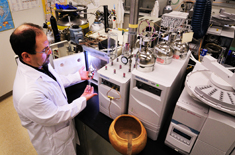NEWS RELEASES
FOR IMMEDIATE RELEASE
December 3, 2007
Did early Southwestern Indians ferment corn and make beer?
Sandia research finds samples provocative but inconclusive
 Sandia researcher Ted Borek used gas chromatography and mass spectrometry to analyze vapors produced by mild heating of pot sherd samples. (Photo by Randy Montoya)
Sandia researcher Ted Borek used gas chromatography and mass spectrometry to analyze vapors produced by mild heating of pot sherd samples. (Photo by Randy Montoya)Download 300dpi JPEG image (Media are welcome to download/publish this image with related news stories.)
ALBUQUERQUE, N.M. —The belief among some archeologists that Europeans introduced alcohol to the Indians of the American Southwest may be faulty.
Ancient and modern pot sherds collected by New Mexico state archeologist Glenna Dean, in conjunction with analyses by Sandia National Laboratories researcher Ted Borek, open the possibility that food or beverages made from fermenting corn were consumed by native inhabitants centuries before the Spanish arrived.
Dean, researching through her small business Archeobotanical Services, says, “There’s been an artificial construct among archeologists working in New Mexico that no one had alcohol here until the Spanish brought grapes and wine. That’s so counter-intuitive. It doesn’t make sense to me as a social scientist that New Mexico would have been an island in pre-Columbian times. By this reasoning, ancestral puebloans would have been the only ones in the Southwest not to know about fermentation.”
Not only does historical evidence for fermented beverages exist for surrounding native groups, but people around the world have found ways to alter their consciousness, she says: “Wild yeast blows everywhere.” In the Middle Ages in Europe, “Everyone drank ale because the fermentation purified water.” Egyptian tombs contained loaves of bread “that we used to assume were to eat, but they’re actually dry beer: put bread in water, you get beer.”
Closer to home, the Tarahumara Indians in northern Mexico to this day drink a weak beer called tiswin, made by fermenting corn kernels.
Could ancestral puebloan farmers — whose ancient mud and rock homes have been found in New Mexico, Arizona, Utah, and Colorado — have done the same?
To check her hypothesis, Dean presented Borek with three types of samples: pots in which she herself brewed tiswin, brewing pots used by Tarahumara Indians, and pot sherds from 800-year-old settlements in west-central New Mexico. The question: would analysis support the idea that ancient farmers enhanced their nutrition — and perhaps enjoyment of foods — by manipulating wild yeast and corn mixtures centuries before Columbus?
Borek, working under a Sandia program that permits limited use of Sandia tools to aid local small businesses, used gas chromatography and mass spectrometry (rather than destructive solvents) to analyze vapors produced by mild heating of the pot samples.
Sandia is a National Nuclear Security Administration laboratory.
From Dean’s pots, Borek developed a profile of gasses emitted from a known tiswin source. Then he examined Tarahumaran pots to see whether the gaseous profiles corresponded. Finally he examined pot sherds that had been buried for centuries to see if the obviously weakened fumes would match, in kind if not in volume, his previous two samples.
Comparing peaks across the three data sets showed the presence of similar organic species, Borek says, though more work must be done before positive conclusions can be drawn.
“We see similarities. We have not found that ‘smoking gun’ that definitely provides evidence of intentional fermentation. It’s always possible that corn fermented in a pot without the intent of the owner,” he says, “and that it wasn’t meant to be drunk.”
Analysis is now underway to highlight patterns of organic species that might provide a more definite, intentional result.
“There appear to be consistencies across the modern home brew and Tarahumaran pots,” Borek says. “We are currently examining all data to look for markers that would indicate intentional fermentation occurred on archeological articles.”
The work opens new, unexpected doors, he says, for understanding the human past by means of gas chromatography and mass spectrometry.
Sandia researcher Curt Mowry is examining data and comparing all sets across the provided references, Tarahumaran pots, and ancient samples.
The results were presented by Borek in a talk at the Materials Research Society fall meeting in Boston last week.
The equipment used in this study is commercially available hardware, modified by Sandia to investigate traces of organic materials in the ambient air of the Washington DC Metro system and on weapon components and materials.
Sandia is a multiprogram laboratory operated by Sandia Corporation, a Lockheed Martin company, for the U.S. Department of Energy’s National Nuclear Security Administration. With main facilities in Albuquerque, N.M., and Livermore, Calif., Sandia has major R&D responsibilities in national security, energy and environmental technologies, and economic competitiveness.
Sandia news media contact: Neal Singer, nsinger@sandia.gov, (505) 845-7078